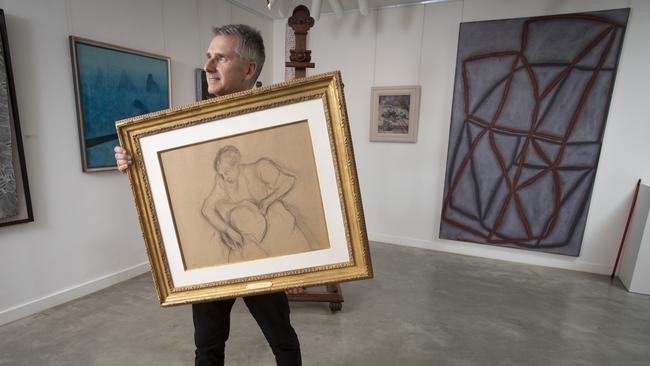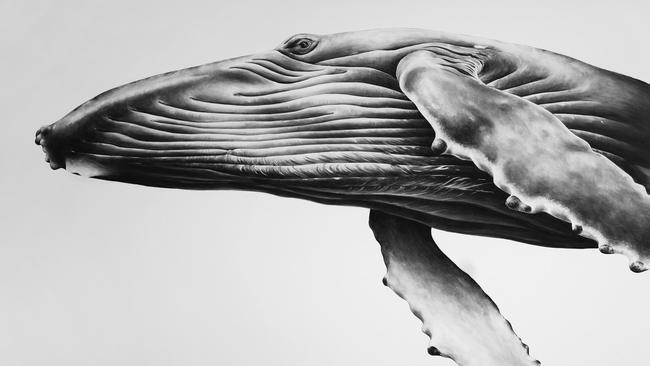More than a token effort: where art and crypto worlds collide
Justin Miller is one of Australia’s most trusted art advisers. He was chairman of Sotheby’s Australia. Now he brings us crypto art, non fungible tokens.

Justin Miller is one of Australia’s most trusted art advisers. He was chairman of Sotheby’s Australia for more than a decade. And now he brings us crypto art. Next Thursday, he will be auctioning off non fungible tokens, or NFTs, for new digital works by eight young Australian artists authenticated on the ethereum blockchain.
Miller has hooked up with old school mate, businessman and crypto crusader Mark Carnegie, and artist and educator professor Ross Harley. “We wanted to educate ourselves,” Miller says.
Welcome to 2021, the age of NFTs popularised by CryptoPunks, Bored Apes and Paris Hilton and lots of money.
Is it just the latest craze or a new disruptive genre in art – art as “offensive” as Degas’s impressionism? Or is it, as Carnegie believes passionately, a paradigm shift that will democratise art and transform our lives and experiences?
“It’s going to change the world 10 times as big as the internet did,” Carnegie tells The Weekend Australian from London.
“And not because it is valuing art. It is a new way of thinking about power relationships and the cognitive landscape of the world. You are on this bus or it’s going to run you over.”
Two weeks ago, Sotheby’s sold a single Bored Ape NFT for $4.4m. To the uninformed, it is a crude digital cartoon of a bored ape with a party whistle. But it is unique and authenticated.
NFTs are easy to define on paper. Truly understanding their worth makes the head hurt.
NFTs are tokens that represent ownership of pieces of art or collectables that are authentically verified by the etherium blockchain. They are non-fungible because each token is unique and cannot be swapped out.
There are remarkable, inspirational and clever works and there are emperors running around all over the place with no clothes on. That is no doubt what piques the interest of curator Miller.
“You take Justin and Ross, two of the most conservative important figures in Australian art and you watch them go, in 120 or 180 days. There is nobody who has gone down this rabbit hole and said it’s not going to change the world,” Miller says.
Backed by Carnegie, Mint NFT is Australia’s first collective of fine art professionals, bringing them to the blockchain. “We are the first to do this and I think the first to do it charitably,” says Miller. “We are saying to artists let’s look at this together because we see a great thing where artists can be empowered by this technology.”
The eight artists have been given funds and tools to explore whether NFTs can really make for a sustainable career. “An artist can say my art work is now on the blockchain, it’s been minted,” Miller says. “And with the smart contract associated with that artwork I can say I want this to do with copyright, I want this to do with resale, that’s very traceable and trackable.”
Nina Pether, an art adviser at Miller’s gallery, says the days of physical art copyright where there is that 5 per cent resale royalty are long gone. “Blockchain ensures for the life of the work that the artist will retain a royalty forever, because it is recorded permanently on a digital ledger as the NFT changes hands,” Pether says.
The digital art produced by the artists is deliberately new territory, “as opposed to just spinning unicorns, as Mark says,” Miller quips.
Watercolourist Jamie Poole’s giant whale spans a wall in the real world. The work has been digitised and animated to move with music. “Her motto is art for purpose,” says project manager at the gallery, Mez Mia. “Every time her digital NFT is sold a portion of that money will always go to the rainforests.”
Eva Nolan works intricately in pencil and charcoal, which she has scanned and then digitised. Her hero work include 24 Australian endangered species that glitch in and out. “With younger artists and younger collectors, they look at social impact with artwork,” Miller says. “It is quite a new thing, the force of it.”
Nolan and Poole have chosen to keep the physical original works. Their NFTs clearly add some value. But what about an NFT that is little more than a GIF file? And what is the value of an original footy card from the 60s as compared to an NFT of that card?
It’s a good question, says Miller. “Damian Hirst has just released 10,000 artworks and has put them in secure store. You can buy either the physical artworks or you can buy the NFTs. So he is playing around with that.”
Mez Mia argues there is always someone who can’t understand the value. “What I found super interesting was the most recent Sotheby sale of Paris Hilton’s collection, of all people. These works are retaining and growing in value. There is a secondary market. It’s not just a fad.”
NFTs open a wonderland of innovation in digital art and slicing and dicing of what ownership actually confers. Seven-time Super Bowl champion Tom Brady is releasing an NFT platform called Autograph to capture the big names in sport an entertainment.
Miller is well down the rabbit hole. But this trip has elements of Alice in Wonderland. “You think about Tom Brady and Paris Hilton wanting to hang out with Vitalik (Buterin, co-founder of ethereum), the world has turned upside down” says Carnegie.
Miller says the fascination comes from the under-35s. “The impressionists from the 1870s were scoffed at by the majority of the art world. Degas was the most avant-garde of the avant-garde. So many of those artists were. Their works were seen as being incomplete. But the best were curated and promoted and around 1900, tens of thousands of people were painting in an impressionist style. The best of those artists we still remember, whether it is a Degas or a Renoir.”
The same is true for the pop art of the 1960s with Jasper Johns and Andy Warhol.
“People were collecting Vermeers at the time,” Miller says. “No one was collecting lithographs, they are not even one-offs, they were multiples of soup cans. And a dealer Leo Castelli came along and said hang on, there is something in this and nowadays we almost look on Andy Warhol as being a historical figure.
“There are so many creatives out there. It is not just spinning imagery and illuminated covers of magazines, this is where we saw a role for curatorship, because you have to work out who are the innovators and who are the imitators.”
Once on the blockchain, the tokens open a wonderland of innovation in digital art and slicing and dicing of what ownership actually confers.

NFTs appeared in 2017 with 10,000 different CryptoPunks created by studio Larva Labs that became cult items. The craze took off in 2021 with the Bored Ape Yacht Club. This time it was 10,000 bored apes created by four friends at Yoga Labs.
Purchasing a Bored Ape has benefits. “If you want to hang out online in the board ape swamp with a whole bunch of other cool people who own a Bored Ape, it’s like a club membership,” Miller says. “And there is a status arrived from owning a CryptoPunk, because you are one of the early people who got into that field. If 20 years after you bought a Warhol you are one of the clever people to buy a Warhol, how cool to have an original Warhol, even though it’s one of a thousand multiples.”
Between now and January, the British Museum is releasing NFTs of renowned works, fractionalised to allow “ownership” of an unobtainable piece of art and “membership”.
Mint NFT artist Mark Bo Chu uses the Bored Ape concept with his Crypto Crimz, creating an army of criminals from the common to the rare, all with backstories and led by ten Dons. From a touch of Sopranos to Skater Boy, he plans to build a universe around them.
For young artist notnotcamscott, the value is in digitising his street art and inviting patronage to street artists. And he is bringing back to life “casualties” in street art that has been posted over and is given a second run on blockchain. There are 10 copies of each piece of art, like a limited edition print.
Another aspirational story for Mint NFT comes from internationally acclaimed Indigenous artist Wukun Wanambi. Partnering with the Buka Art Centre at Yirrkala, a Wanambi bark painting has been 3D-scanned with images fractionalised into 18 pieces, each with an NFT. The owner will be able to see the full work. And a portion of every sale goes back to the gallery to buy the original art that it could not otherwise afford.
“We do want to educate older collectors,” insists Miller. “Good collectors by their very nature want to know what’s going on. Why do they tromp around this art precinct on a Sunday afternoon? Why do they go to the Museum of Contemporary Art? I’ve had friends in their 70s who say the moment you have this up and running please let me know.”



To join the conversation, please log in. Don't have an account? Register
Join the conversation, you are commenting as Logout